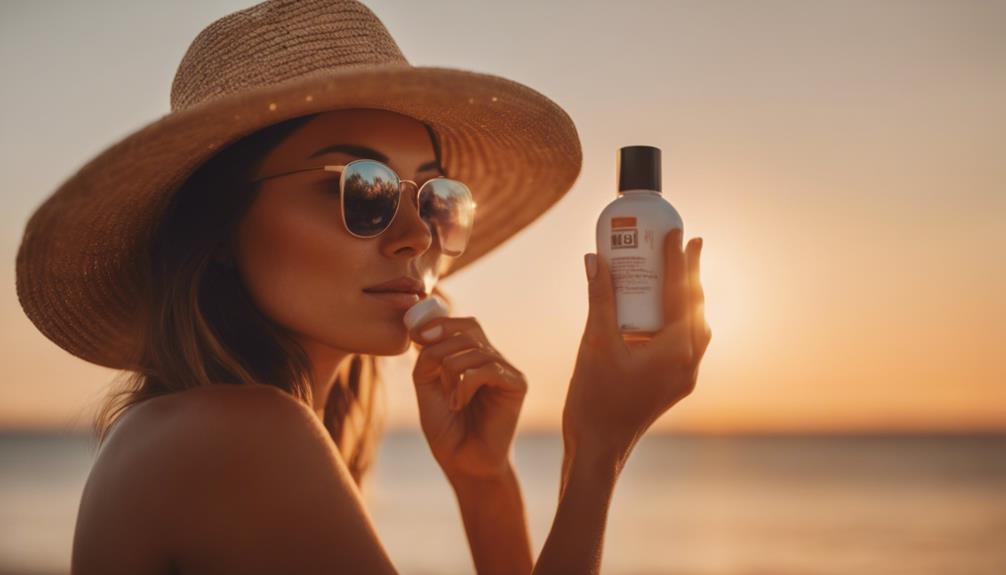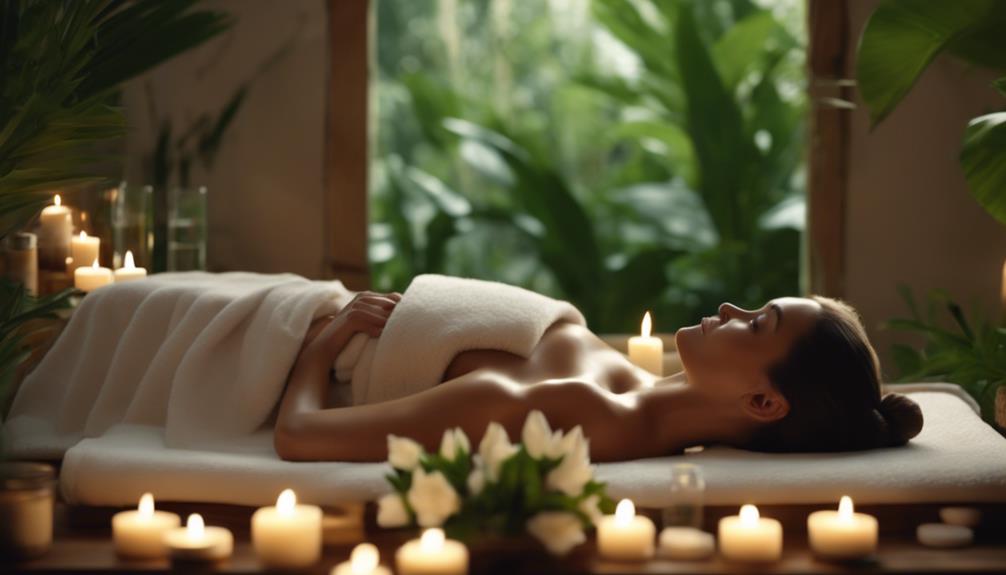To avoid getting “raccoon eyes” while tanning, it’s important to follow a few steps. Begin by exfoliating your skin the day before to create a smooth surface for an even tan. Wear properly fitted eyewear made for tanning beds to protect your eyes from UV rays and prevent uneven tan lines. Make sure to adjust your eyewear as needed to ensure proper coverage during your tanning session. After tanning, remember to keep your skin moisturized to maintain that beautiful glow. By following these suggestions, you can achieve a flawless tan. If you’re interested in discovering more effective techniques, there are many options you can explore. Translated in English (United States)
Key Takeaways
- Use specialized tanning eyewear to block UV rays and prevent raccoon eyes from forming during tanning sessions.
- Apply a barrier cream or lotion around the eyes before tanning to minimize tan lines.
- Regularly adjust your eye protection position while tanning to ensure an even tan around the eyes.
- Exfoliate and clean your face thoroughly before tanning to create a smooth, even surface for tanning.
Understanding Raccoon Eyes
When you tan, the delicate skin around your eyes often absorbs less UV light, resulting in raccoon eyes that can disrupt your overall look. This area tends to tan unevenly, leaving darker patches around your eyes.
To combat this, consider adjusting your eye protection during tanning sessions. You might also want to shift positions to minimize tan lines. Remember, the eyelid skin is thinner and doesn't tan the same way as the rest of your face, so give it special attention.
Gradually building your base tan helps achieve a more natural appearance, avoiding severe contrasts. Finally, be mindful of the skincare products you use, as they can affect how your skin tans, potentially leading to more noticeable raccoon eyes.
Effective Pre-Tan Preparation
Effective pre-tan preparation is essential for achieving an even and beautiful glow, so make sure to start with a clean canvas by washing your face thoroughly.
Remove any SPF and makeup to prevent uneven tanning.
Next, gently exfoliate your skin to eliminate dead cells, focusing on areas prone to unevenness. This step promotes a smooth application and enhances your tan.
After exfoliating, apply a lightweight, hydrating moisturizer to keep your skin supple. Avoid the eye area when applying bronzer to prevent dark circles.
Finally, establish a structured routine, allowing your skin to absorb products fully before tanning.
Choosing the Right Eyewear

Choosing the right eyewear can greatly impact your tanning results and help prevent raccoon eyes. When you're tanning, opt for eye protection specifically designed for tanning beds. This guarantees a proper fit that covers your eyes effectively, blocking harmful UV rays while minimizing tan lines.
Look for adjustable options to enhance comfort as you relax under the lights. Quality eyewear not only safeguards your eyes but also helps maintain a flawless bronze. If you prefer disposables, choose ones that allow customization for your unique face shape.
Always remember to position your eyewear correctly and stay aware of your body's positioning. Doing so will optimize your tanning experience and keep those pesky raccoon eyes at bay!
Maintaining Your Tan
To keep your tan looking vibrant and even, regularly moisturize your skin to enhance hydration and longevity.
After tanning, apply a hydrating moisturizer to lock in moisture and maintain that beautiful glow.
Space your tanning sessions about 5-7 days apart to prevent overexposure and allow your skin to recover.
Watch for signs of dryness or peeling, and adjust your tanning frequency if needed.
Incorporate a gentle exfoliant into your routine to remove dead skin cells, which can help your tan last longer.
Always stay hydrated by drinking plenty of water, as it supports skin health.
With consistent care, you'll enjoy a stunning, even tan that lasts!
Remedies for Tan Lines

Camouflaging tan lines can be easily achieved with a few simple remedies tailored to your skin tone.
Start by using a waterproof foundation that matches your tan or is one shade lighter to blend the lines seamlessly. You can also apply bronzing powder over the affected areas for a quick fix; just make sure to blend well.
If you're looking for a more targeted approach, touch-up pens can quickly even out any discrepancies. Before your next tanning session, apply a barrier cream or lotion around your eyes to prevent unwanted lines.
Tips for Even Tanning
Achieving an even tan requires careful preparation and attention to detail throughout your tanning routine.
Start by exfoliating your skin a day prior to your tanning session to remove dead skin cells and promote a smooth surface.
Before tanning, wash your face to eliminate any makeup or SPF that could interfere with the tan.
Apply bronzer evenly, avoiding the eye area to prevent uneven coloration.
During your session, regularly adjust your eye protection to avoid sharp tan lines.
Keep track of your tanning time, gradually building your base tan rather than rushing.
Protecting Your Skin During Tanning

Protecting your skin during tanning is essential for preventing damage and ensuring an even, radiant glow.
Start by exfoliating your skin to remove dead cells, promoting an even tan.
Always apply a broad-spectrum sunscreen with SPF to shield against harmful UV rays, especially on delicate areas.
Use protective eyewear designed for tanning beds to guard your eyes from intense light.
Remember to moisturize before and after tanning to keep your skin hydrated, which helps maintain your tan longer.
Adjust your eye protection frequently to avoid harsh lines and uneven color.
Frequently Asked Questions
Can I Use Regular Sunglasses for Tanning Protection?
You shouldn't use regular sunglasses for tanning protection. They might not provide adequate UV shielding and can create unwanted tan lines. Instead, opt for specialized tanning eyewear designed to protect your eyes while maintaining an even tan.
How Long Does It Take for Raccoon Eyes to Fade?
You'd think raccoon eyes would take ages to fade, but they actually lighten within a week or two. Just keep moisturizing and give your skin some time; those lines aren't as permanent as they seem!
Are There Specific Products to Prevent Raccoon Eyes During Tanning?
Yes, you can use barrier creams or lotions around your eyes before tanning. Additionally, quality eye protection designed for tanning helps shield the area, preventing unwanted tan lines and ensuring a more even complexion.
What Should I Do if I Accidentally Get Raccoon Eyes?
Did you know that around 40% of tanners experience uneven pigmentation? If you accidentally get raccoon eyes, try using bronzing powder to blend lines, or apply a tinted moisturizer to even out the skin tone.
Is There a Way to Permanently Prevent Raccoon Eyes While Tanning?
You can't permanently prevent raccoon eyes while tanning, but adjusting your eye protection, using barrier creams, and ensuring even bronzer application can greatly reduce the chances of developing those unwanted tan lines.
How Can I Prevent Raccoon Eyes While Tanning?
To prevent raccoon eyes while tanning, it’s important to protect the delicate skin around your eyes. Wear UV-protective sunglasses and adjust them regularly to prevent tan lines. Additionally, consider using a specialized sunscreen stick to avoid smudging your eye area. Achieve your ideal tan with smart visits to the tanning salon.
Conclusion
Don't let raccoon eyes ruin your tanning experience!
With the right prep and protective eyewear, you can achieve that gorgeous, even glow without the hassle of unsightly tan lines.
It's funny how a little attention to detail can lead to such a big difference.
As you bask in the sun, remember that your skin deserves care.
So, embrace these tips, protect your delicate eye area, and enjoy your stunning tan with confidence!










